
The Thomisidae are a family of spiders, including about 170 genera and over 2,100 species. The common name crab spider is often linked to species in this family, but is also applied loosely to many other families of spiders. Many members of this family are also known as flower spiders or flower crab spiders.
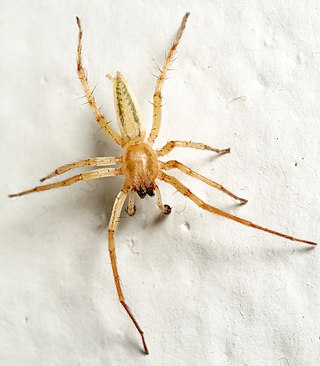
Anyphaenidae is a family of araneomorph spiders, sometimes called anyphaenid sac spiders. They are distinguished from the sac spiders of the family Clubionidae and other spiders by having the abdominal spiracle placed one third to one half of the way anterior to the spinnerets toward the epigastric furrow on the underside of the abdomen. In most spiders the spiracle is just anterior to the spinnerets. Like clubionids, anyphaenids have eight eyes arranged in two rows, conical anterior spinnerets and are wandering predators that build silken retreats, or sacs, usually on plant terminals, between leaves, under bark or under rocks. There are more than 600 species in over 50 genera worldwide.

Cheliferoides is a genus of jumping spiders that was first described by Frederick Octavius Pickard-Cambridge in 1901. As of June 2019 it contains only three species, found only in Guatemala, Panama, and the United States: C. longimanus, C. planus, and C. segmentatus.
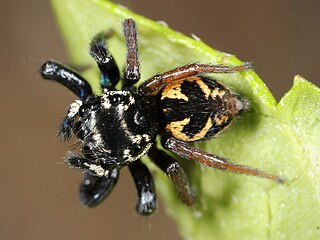
Corythalia is a genus of jumping spiders that was first described by Carl Ludwig Koch in 1850. The genus is distributed throughout most of the Western Hemisphere. Species of this genus are found in The Americas.
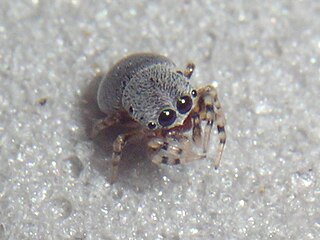
Cylistella is a genus of jumping spiders that was first described by Eugène Louis Simon in 1901.

Metaphidippus is a genus of jumping spiders that was first described by Frederick Octavius Pickard-Cambridge in 1901. The name is combined from Ancient Greek μετά "after, beside" and the salticid genus Phidippus.

Pachomius is a genus of jumping spiders that was first described by George and Elizabeth Peckham in 1896. Uspachia was merged into genus Romitia in 2007, and all nine species were merged into Pachomius in 2015. The name is derived from Pachomius, the founder of cenobitic monasticism.

Paramarpissa is a genus of North American jumping spiders that was first described by Frederick Octavius Pickard-Cambridge in 1901. Originally considered a synonym of Pseudicius, it was separated into its own genus in 1999.

Paraphidippus is a genus of jumping spiders that was first described by Frederick Octavius Pickard-Cambridge in 1901. The name is a combination of the Ancient Greek "para" (παρά), meaning "alongside", and the salticid genus Phidippus.

Phanias is a genus of jumping spiders that was first described by Frederick Octavius Pickard-Cambridge in 1901. They are similar to members of Marpissa, but have three pairs of spines beneath the first tibia.

Sidusa is a genus of jumping spiders that was first described by George and Elizabeth Peckham in 1895.

Tinus is a genus of nursery web spiders that was first described by Frederick Octavius Pickard-Cambridge in 1901.
Metaphidippus pernix is a species of spider in the Salticidae family found in Guatemala.
Metaphidippus mandibulatus is a species of spider in the family Salticidae from Costa Rica. It is the type species of Metaphidippus. The species name was first published in 1901 by Frederick Octavius Pickard-Cambridge.

Zygoballus tibialis is a species of jumping spider native to Central America. It was first described by the arachnologist Frederick Octavius Pickard-Cambridge in 1901. The type specimens are housed at the Natural History Museum in London.
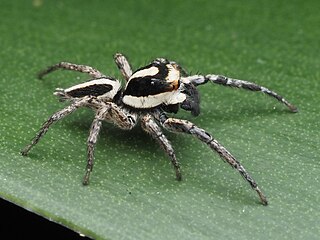
Leptofreya is a genus of spiders in the family Salticidae. It was first described in 2015 by G. B. Edwards. It is found in the Americas from the United States to Brazil.
Titus is a monotypic genus of East African ground spiders containing the single species, Titus lugens. It was first described by O. Pickard-Cambridge in 1901, and has only been found in Zimbabwe.
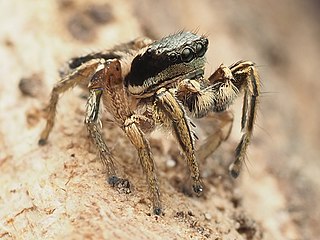
Habronattus mexicanus is a species of jumping spider in the genus Habronattus. The species was first identified in 1896 in Mexico, after which it is named, originally allocated to the genus Habrocestum. The species has subsequently been identified in locations in North and Central America, as well as islands in the Caribbean Sea. The spider is small, but displays one of the most complex sexual displays, including sophisticated vibatory song patterns.
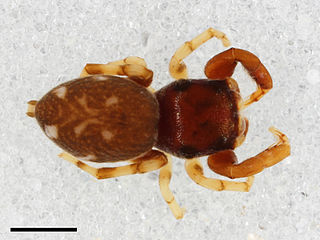
Zygoballus maculatus is a species of jumping spider which occurs in Guatemala. It is known only from a single female specimen held at the Natural History Museum, London. The species was first described in 1901 by the English arachnologist Frederick Octavius Pickard-Cambridge:
Zygoballus maculatus, sp. n.
Type, female, in coll. Godman and Salvin. Total length 3 millim.
Hab. Guatemala (Sarg).
This species is black, with a few white dorsal and marginal spots on the abdomen, and the legs i. brown, and ii., iii., and iv. yellow, annulated with black. It is probably recognizable by the form of the vulva only, for the coloration in these spiders is very variable, the general pattern being common to many of them.















